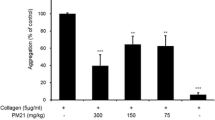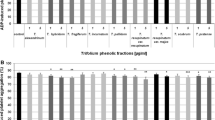Abstract
The effects of ethanol extracts of persimmon leaves (EPL) and the major flavonoids catechin, epicatechin, and epicatechin gallate on blood coagulation and platelet aggregation were evaluated. Anticoagulant activities were examined by monitoring the activated partial thromboplastin time (aPTT) and the prothrombin time (PT). EPL significantly prolonged PT and aPTT. The aPTT was significantly increased in the presence of catechin, epicatechin, and epicatechin gallate, compared with controls. In order to determine the antiplatelet activity, arachidonic acid (AA), collagen, and adenosine diphosphate (ADP)-induced platelet aggregation were examined. PL and the major flavonoids significantly reduced AA-induced platelet aggregation, although they did not significantly affect ADP and collagen-induced platelet aggregation, compared with controls. EPL and the major flavonoids significantly inhibited serotonin, thromboxane A2, and soluble P-selectin generation, compared with controls. PL has potential for prevention and improvement of thrombosis by inhibiting blood coagulation and platelet activation.
Similar content being viewed by others
References
Furie B, Furie BC. Mechanisms of thrombus formation. New Engl. J. Med. 359: 938–949 (2008)
Furie B, Furie BC. Thrombus formation in vivo. J. Clin. Invest. 115: 3355–3362 (2005)
Gopinath SCB, Shikamoto Y, Mizuno H, Kumar PK. A potent anti-coagulant RNA aptamer inhibits blood coagulation by specifically blocking the extrinsic clotting pathway. Thromb. Haemostasis 95: 767–771 (2006)
Gopinath SCB, Shikamoto Y, Mizuno H, Kumar PK. Snake-venom-derived Factor IX-binding protein specifically blocks the gamma-carboxyglutamic acid-rich-domain-mediated membrane binding of human Factors IX and X. Biochem. J. 405: 351–357 (2007)
Charles TE. The interactions between inflammation and coagulation. Brit. J. Haematol. 131: 417–430 (2005)
Kim SY, Koo YK, Koo JY, Ngoc TM, Kang SS, Bae K, Kim YS, Choi HSY. Platelet anti-aggregation activities of compound from Cinnamomum cassia. J. Med. Food 13: 1069–1074 (2010)
Yu HY, Park SW, Chung IM, Jung YS. Anti-platelet effects of yuzu extract and its component. Food Chem. Toxicol. 49: 3018–3024 (2011)
Jennings LK. Mechanisms of platelet activation: Need for new strategies to protect against platelet-mediated atherothrombosis. Thromb. Haemostasis 102: 248–257 (2009)
Cho HJ, Kittaka R, Abdou AM, Kim M, Kim HS, Lee DH, Park HJ. Inhibitory effects of oligopeptides from hen egg white on both human platelet aggregation and blood coagulation. Arch. Pharm. Res. 32: 945–953 (2009)
Konkle BA. Bleeding and thrombosis. 17th ed. pp. 369–369. In: Harrison’s Principles of Internal Medicine. Fauci AS, Braunwald E, Kasper DL. Hauser SL, Longo DL, Jameson JL, Loscalzo J (eds). McGraw Hill, New York, NY, USA (2008)
Badimon JJ, Weng D, Chesebro JH, Fuster V, Badimon L. Platelet deposition induced by severely damaged vessel wall is inhibited by a boroarginine synthetic peptide with antithrombin activity. Thromb. Haemostasis 71: 511–516 (1994)
Kang WS, Lim IH, Yuk DY, Chung KH, Park JB, Yoo HS, Yun YP. Antithrombotic activities of green tea catechins and (−)-epigallocatechin gallate. Thromb. Res. 96: 229–237 (1999)
Burger PC, Wagner DD. Platelet P-selectin facilitates atherosclerotic lesion development. Blood 101: 2661–2666 (2003)
Fan J, Zhang Y, Chang X, Zhang B, Jiang D, Saito M, Li Z. Antithrombotic and fibrinolytic acitivities of methanolic extract of aged sorghum vinegar. J. Agr. Food Chem. 57: 8683–8687 (2009)
Gopinath SCB. Anti-coagulant aptamers. Thromb. Res. 122: 838–847 (2008)
Tanaka KA, Key NS, Levy JH. Blood coagulation: Hemostasis and thrombin regulation. Anesth. Analg. 108: 1433–1446 (2009)
Hu FB. Plant-based foods and prevention of cardiovascular disease: An overview. Am. J. Clin. Nutr. 78: 544S–551S (2003)
Kim KY, Lim KM, Kim CW, Shin HY, Seo DB, Lee SJ, Noh JY, Bae ON, Sin S, Chung JH. Black soybean extract can attenuate thrombosis through inhibition of collagen-induced platelet activation. J. Nutr. Biochem. 22: 964–970 (2011)
Jung UJ, Park YB, Kim SR, Choi MS. Supplementation of persimmon leaf ameliorates hyperglycemia, dyslipidemia and hepatic fat accumulation in type 2 diabetic mice. PloS One 11: e49030 (2012)
Morel I, Lescoat G, Cogrel P, Sergent O, Pasdeloup N, Brissot P, Cillard P, Cillard J. Antioxidant and iron-chelating activities of the flavonoids catechin, quercetin and diosmetin on iron-loaded rat hepatocyte cultures. Biochem. Pharmacol. 45: 13–19 (1993)
Sa YS, Kim SJ, Choi HS. The anticoagulant fraction from the leaves of Diospyros kaki L. has an antithrombotic activity. Arch. Pharm. Res. 28: 667–674 (2005)
Miao M, Zhang X, Wang L. Persimmon leaf flavonoid induces brain ischemic tolerance in mice. Neural. Regen. Res. 8: 1376–1382 (2013)
Dejana E, Quintana A, Callioni A, de Gaetano G. Bleeding time in laboratory animals. III-Do tail bleeding times in rats only measure a platelet defect? (the aspirin puzzle). Thromb. Res. 15: 199–207 (1979)
Born GVR. Aggregation of blood platelets by adenosine diphosphate and its reversal. Nature 194: 927–929 (1962)
World Health Organization. The top 10 causes of death. Available from: http://www.who.int/mediacentre/factsheets/fs310/en/. Accessed May 31, 2013.
Barrett NE, Holbrook L, Jones S, Kaiser WJ, Moraes LA, Rana R, Sage T, Stanley RG, Tucker KL, Wright B, Gibbins JM. Future innovations in anti-platelet therapies. Brit. J. Pharmacol. 154: 918–939 (2009)
Lee SM, Moon J, Chung JH, Cha YJ, Shin MJ. Effect of quercetin-rich onion peel extracts on arterial thrombosis in rats. Food. Chem. Toxicol. 57: 99–105 (2013)
Heemskerk JWM, Bevers EM, Lindhout T. Platelet acitivation and blood coagulation. Thromb. Haemostasis 88: 196–193 (2002)
Gratacap MP, Hérault JP, Viala C, Ragab A, Savi P, Herbert JM, Chap H, Plantavid M, Payrastre B. FcγRIIA requires a Gi-dependent pathway for an efficient stimulation of phosphoinositide 3-kinase, calcium mobilization, and platelet aggregation. Blood 96: 3439–3446 (2000)
Lee W, Yang EJ, Ku SK, Song KS, Bae JS. Anticoagulant activities of oleanolic acid via inhibition of tissue factor expressions. BMB Rep. 45: 390–395 (2012)
Whiteheart SW. Platelet granules: Surprise packages. Blood 118: 1190–1191 (2011)
Clutton P, Folts JD, Freedman JE. Pharmacological control of platelet function. Pharmacol. Res. 44: 255–264 (2001)
Halushka PV, Allan CJ, Davis-Bruno KL. Thromboxane A2 receptors. J. Lipid Mediat. Cell 12: 361–378 (1995)
Son DJ, Cho MR, Jin YR, Kim SY, Park YH, Lee SH, Akiba S, Sato T, Yun YP. Antiplatelet effect of green tea catechins: A possible mechanism through arachidonic acid pathway. Prostag. Leukotr. Ess. 71: 25–31 (2004)
Jin YR, Im JH, Park ES, Cho MR, Han XH, Lee JJ, Lim Y, Kim TJ, Yun YP. Antiplatelet activity of epigallocatechin gallate is mediated by the inhibition of PLCgamma2 phosphorylation, elevation of PGD2 production, and maintaining calcium-ATPase activity. J. Cardiovasc. Pharm. 51: 45–54 (2008)
Author information
Authors and Affiliations
Corresponding author
Rights and permissions
About this article
Cite this article
Ryu, R., Jung, U.J., Seo, YR. et al. Beneficial effect of persimmon leaves and bioactive compounds on thrombosis. Food Sci Biotechnol 24, 233–240 (2015). https://doi.org/10.1007/s10068-015-0031-1
Received:
Revised:
Accepted:
Published:
Issue Date:
DOI: https://doi.org/10.1007/s10068-015-0031-1




